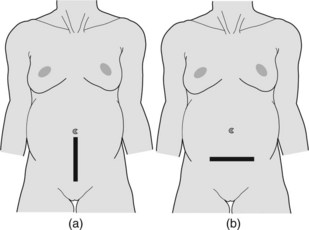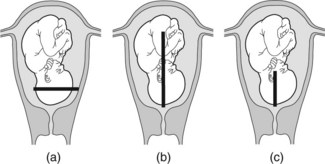Chapter 17 Caesarean section
Caesarean section describes the surgical procedure for delivery of the fetus by incisions through the abdomen and uterus. The attendant risk of a surgical procedure must be considered. In the UK direct deaths following all caesarean sections is 82.3 per 1 000 000. For elective procedures this is 38.5 per 1 000 000. Death rate following vaginal delivery is 16.9 per 1 000 000 maternities (Department of Health (DoH) 2001). Pulmonary embolism, hypertension haemorrhage and sepsis continue to be salient causes of mortality. Inappropriate delegation, inadequate facilities and poor communication contribute to substandard care and necessitate improvement.
INDICATIONS FOR CAESAREAN SECTION
Caesarean sections are performed to:
PREOPERATIVE CARE
POSTOPERATIVE CARE
TYPES OF INCISION
Abdominal incisions
Essentially these are the subumbilical midline and transverse lower abdominal incisions (Figure 17.1).
Subumbilical midline incision
This incision is easy and quick. Access is good with minimal bleeding. It is useful when access to the lower segment is difficult, for example severe kyphoscoliosis or anterior lower segment fibroid. The scar however, is unsightly, there is more postoperative discomfort and dehiscence is more likely compared with transverse incisions.
Uterine incisions
Entry into the uterus can be through a midline or a transverse lower segment incision (Figure 17.2).





